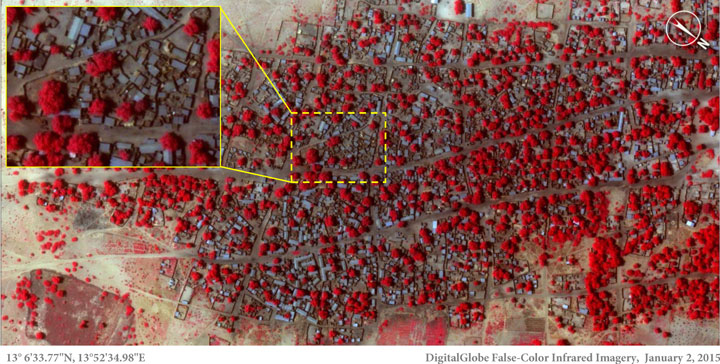TORONTO – The scale of the carnage and massacre is unprecedented according to Amnesty International which today released detailed satellite images painting a grim picture of suffering and loss after Boko Haram militants stormed at least two towns in Nigeria.

These depict the stark contrast before and after the seige in early January which left around 150 people dead according to Nigerian government officials.
“Essentially these two towns have been almost completely wiped off the map,” said Amnesty International Secretary General Alex Neve.
More than 3,700 structures have been damaged or completely destroyed.
But outrage and mourning for this massacre seems muted in comparison to the attacks in Paris, where ten journalists and two police officers were killed in a series of attacks.
READ MORE: International force mulled to fight Boko Haram insurgency in Nigeria
“It just wasn’t fair. People weren’t paying attention to Baga while everyone was paying attention to Paris,” said Bilikisu Balogun, an international relations student at the University of Toronto who’s from Nigeria. “I feel as though in third world countries, the lives that are shed aren’t as equally important.”
There are many reason underpinning the disparity in coverage according to Ivor Shapiro the chair at Ryerson’s School of Journalism.
“Sometimes the answers are very logistical, something is very far away, something is very expensive, or there simply isn’t any video footage availble,” Shapiro said.
Baga is also in an extremely isolated region of Nigeria considered very hazardous for foreign media.
READ MOREL: Boko Haram kills as many as 2,000 in Nigeria: Amnesty International
Conversely, Paris is a major metropolitan centre which has made it easy for the eyes of the media world to penetrate.
In a show of solidarity following the tragedy, world leaders linked arm in arm in solidarity among the (whatever number) others who participated in the largest rally in the country’s history.
These factors fuelled a higher level of traction on social media.
But logistics and risk-level don’t tell the entire story. The attack in Paris was an attack against the universally cherished right to free speech.
France is also a place that seems more familiar to a North American audience.
“That is the thing that we’re all uncomfortable about when we say news is bigger news when it touches our readership or our viewership,” said Shapiro.
For many in the Black community, however, the black lives lost at the massacre at Baga must be recognized as well.
“We talk about black lives as wasted lives. People hear about a shooting, and then they make a connection: ‘there we go again.’ And I think that’s problematic,” explained George Dei, professor of social justice education at the University of Toronto.
“I think we need to think of it as all lives matter, all lives are important, all lives are significant. What happens in Africa, also has implications on what happens in the West.”






Comments